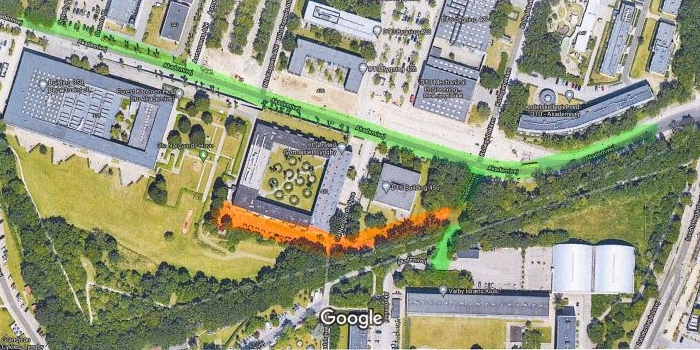Nils Koppels Allé, which separates the 3rd and 4th quadrants at DTU Lyngby Campus, is named after the architect of the buildings that DTU moved into in 1974. But the work was not his alone. He created the drawings in collaboration with his wife, Eva Koppel. Several have therefore called for the street name to be changed, and that call has been heard. The new name is simply Koppels Allé.
Similarly, the name Ole Nørgaards Have is changed to Nørgaards Have, likewise in recognition of the fact that Ole Nørgaard’s wife, Edit Nørgaard, contributed greatly to the shaping of the landscape surrounding the buildings.
At the southern end of the campus area, a new street has been made that gives access to buildings 450 and 451. It’s name will be Julie Arenholts Vej.
At this photo from Google Maps, Julie Arenholts Vej is marked in orange. The green line marks Akademivej.
Julie Arenholt was one of the first female engineers in Denmark. In 1896 she paid for her own entrance exam to the College of Advanced Technology, and in 1901 she completed her studies as Denmark’s first female factory engineer and the third female MSc in engineering.
After graduating, she worked for a few years as a laboratory assistant, but from 1910 until her retirement in 1939 she was a factory inspector in the Danish directorate of labour and factory supervision, where she oversaw working and hygiene conditions in bakeries and pastry shops in Copenhagen and the Frederiksberg area.
She was appointed in spite of opposition from then director Haldor Topsøe, and the fact that a women was meant to supervise companies almost exclusively employing men received a fair amount of attention from the press.
Julie Arenholt was politically active all her adult life. She was among the main initiators of the formation of the National League for Women’s Suffrage in Denmark, and from 1918 to 1921 she was chairman of the Danish Women’s Association and also served on various technical committees.
In 1909—after women had been given the right to vote for the municipal councils—she was elected as Citizens’ Representative of the Danish Social-Liberal Party.
She also made her mark internationally and was a prominent figure at the international women’s movement congresses, and from 1923 to 1929 she served on the central board of the International Woman Suffrage Alliance.
In 1930 she co-founded the Danish branch of Open Door, an international organization founded in 1929 aiming to ensure equal economic opportunities for women.





0 Comments
please do not spam link